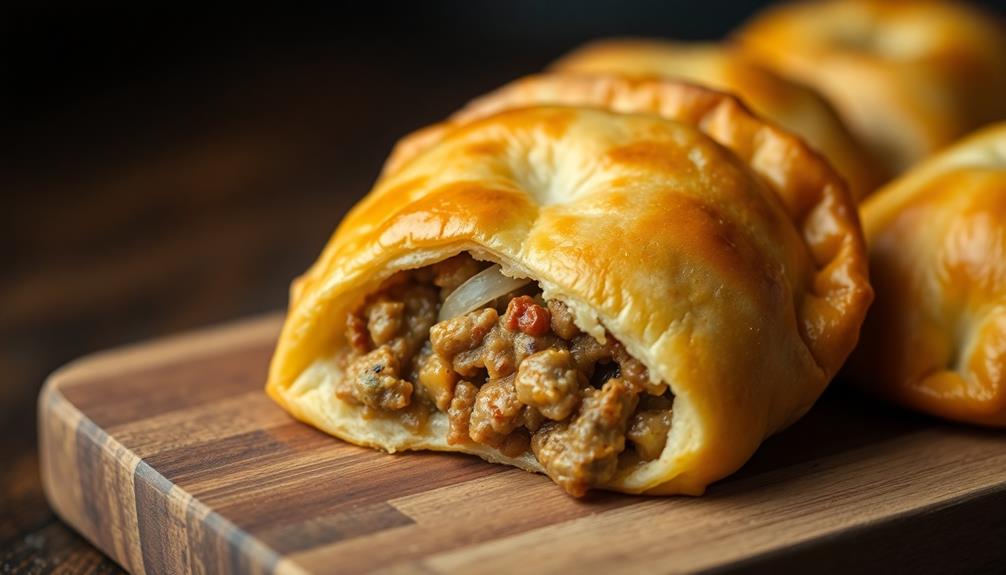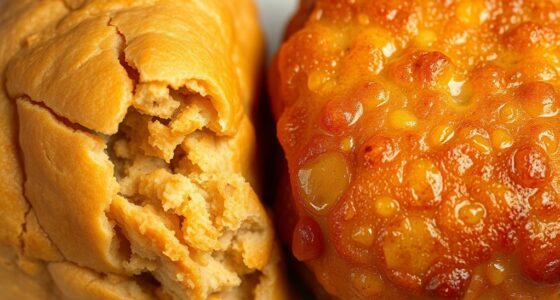Sambousek, the beloved Lebanese empanadas, have ancient roots tracing back to Mesopotamia. Over time, unique regional variations emerged across the Middle East. The traditional Lebanese version features a crisp, golden-brown crust filled with aromatic ground meat, onions, and spices. These savory treats are a cherished part of family gatherings and community celebrations, symbolizing cultural heritage. The irresistible aroma of toasted sesame seeds and warm dough creates a sensory experience that'll have you craving more. With a little practice, you can master the art of making these delightful pastries at home. Curious to learn the step-by-step process? One popular variant of sambousek is filled with creamy, tangy cheese, which creates a delightful contrast to the flaky exterior. Another traditional Lebanese pastry, maamoul cookies, are typically enjoyed during religious holidays and special occasions. If you’re interested in learning the maamoul cookies recipe, it involves shaping a delicate dough around a sweet, spiced filling before baking to perfection. Whether you’re a novice in the kitchen or an experienced cook, exploring these Lebanese pastries will add a delicious touch to your culinary repertoire.
Key Takeaways
- Sambousek is a traditional Lebanese pastry with ancient origins traced back to Mesopotamia, featuring a crisp, golden-brown crust and savory fillings.
- Unique regional variations of sambousek have developed across the Middle East as the dish spread, showcasing the cultural diversity of the region.
- The preparation of sambousek involves rolling out dough, filling it with a mixture of ground meat, onions, and spices, and then baking or frying it until crispy.
- Sambousek is a popular dish at family gatherings and community celebrations in Lebanon, symbolizing the cultural heritage and culinary traditions of the country.
- The aroma of toasted sesame seeds and warm dough creates an irresistible sensory experience, making sambousek a beloved snack or appetizer.
History
The origins of sambousek, a beloved Lebanese pastry, can be traced back to ancient Mesopotamia. Centuries ago, skilled cooks in this region began experimenting with flaky dough and savory fillings, eventually perfecting the hand-held delicacy we know as sambousek today.
As the dish traveled across the Middle East, it took on unique regional variations. In Lebanon, the traditional sambousek features a crisp, golden-brown crust encasing a delectable blend of ground meat, onions, and spices.
The vibrant flavors and satisfying texture have made this portable snack a staple at family gatherings and community celebrations.
Biting into a freshly baked sambousek transports you to the bustling streets of Beirut, where vendors offer these mouth-watering pastries alongside fragrant cups of Arabic coffee.
The aroma of toasted sesame seeds and warm, flaky dough creates an irresistible sensory experience that has captivated generations of Lebanese food lovers.
Cooking Steps
To begin the cooking process, preheat your oven to 375°F (190°C). Gather your ingredients and let's get started!
Roll out the dough on a lightly floured surface until it's about 1/8-inch thick. Cut the dough into circles using a 4-inch round cutter. Place a spoonful of the filling in the center of each circle. Fold the dough over to create a half-moon shape and press the edges to seal.
Next, arrange the filled sambousek on a baking sheet lined with parchment paper. Brush the tops with beaten egg or milk to give them a golden shine. Bake for 18-20 minutes, or until the pastry is crispy and light golden brown. Keep a close eye to ensure they don't burn.
Once out of the oven, let the sambousek cool for a few minutes before serving. Enjoy these delicious Lebanese treats with your family and friends! The flaky pastry and savory filling are sure to delight.
Step 1. Make Dough by Hand-Mixing

Start by hand-mixing the dough in a large bowl. Get ready to channel your inner chef!
First, add the all-purpose flour, salt, and baking powder. Use your fingers to gently mix these dry ingredients together.
Next, create a well in the center and pour in the warm water and olive oil. Start mixing the wet and dry ingredients, working your way from the middle outwards.
Knead the dough for about 5 minutes, until it becomes smooth and elastic. If it's a bit sticky, add a sprinkle of flour.
Once the dough is ready, form it into a ball, place it in a lightly oiled bowl, and cover with a damp towel. Let it rest for 30 minutes. This allows the gluten to develop, giving the dough a nice chew.
After the rest, your dough is ready to be rolled out and filled with the delicious sambousek mixture. Get excited – the flaky, savory goodness is just around the corner!
Step 2. Roll Out Dough Into Circles
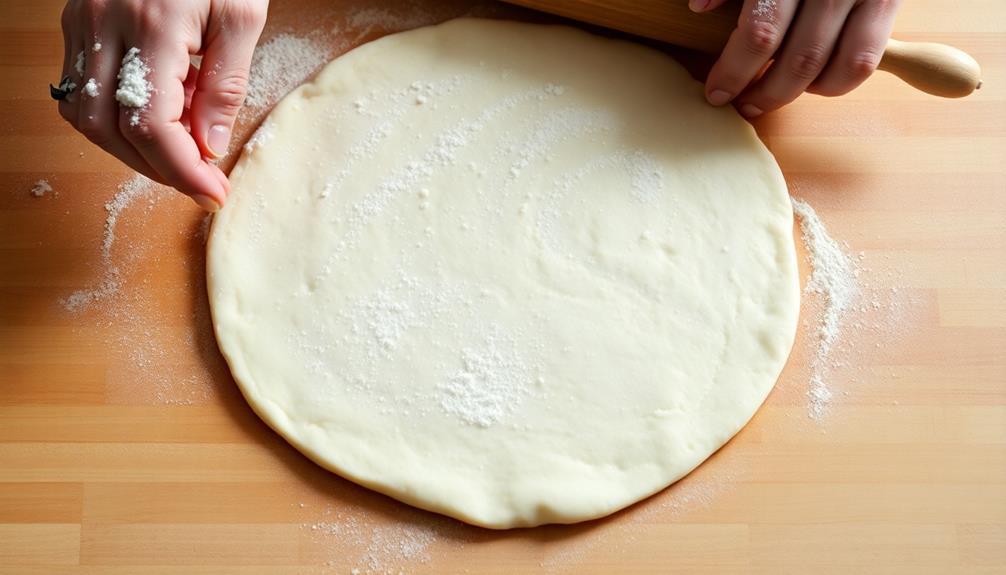
After letting the dough rest, it's time to get rolling! Grab your rolling pin and a clean, floured surface. Gently place a portion of the dough onto the surface and start rolling it out into a thin, circular shape.
Don't be afraid to add a sprinkle of flour if the dough starts to stick. Keep rolling until the dough is about 1/8 inch thick and roughly 6 inches in diameter.
Next, use a sharp knife or round cookie cutter to trim the edges, creating a neat, circular shape. Don't worry if the dough doesn't form a perfect circle – the rustic look is part of the charm!
Carefully transfer the rolled-out dough circle to a lightly floured baking sheet. Repeat this process with the remaining dough, stacking the circles on the baking sheet as you go.
Once all the dough is rolled out, you'll be ready to fill and fold your delicious Sambousek.
Step 3. Fill Dough Circles
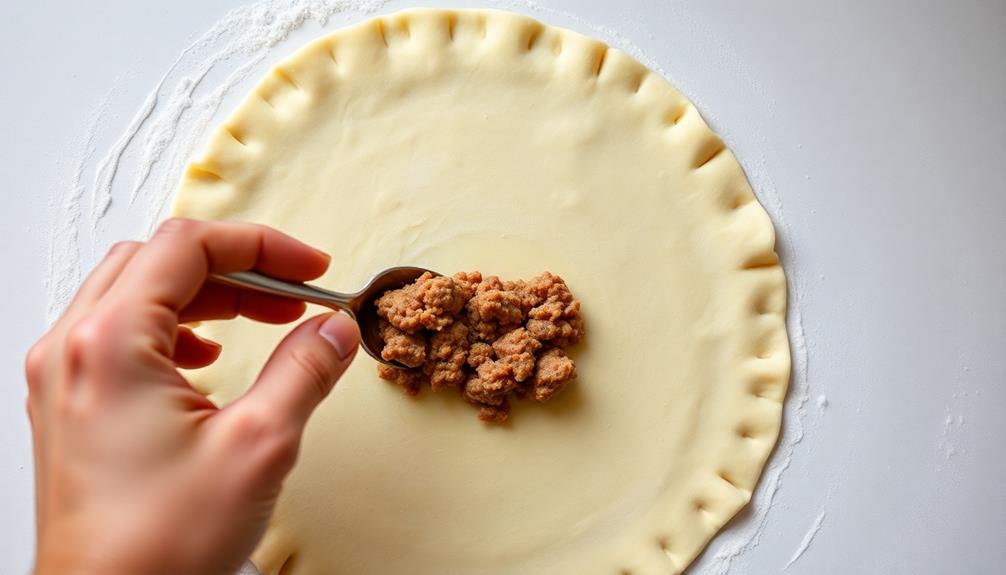
Now that you have your dough circles ready, it's time to fill them. Grab a small spoonful of the delicious filling you prepared earlier. Carefully place it in the center of one of your dough circles.
Be sure not to overstuff it, as you'll need to fold the dough over. Gently fold the dough in half, creating a half-moon shape. Use your fingers to crimp and seal the edges, making sure there are no gaps. This will help the filling stay inside as your Sambousek cooks.
Repeat this process with the remaining dough circles, until you've filled them all. Once they're all filled and sealed, you're ready to move on to the next step: frying your delectable Sambousek to golden perfection!
Get ready for the mouthwatering aroma to fill your kitchen as these Lebanese empanadas sizzle to a crispy finish.
Step 4. Crimp and Seal Filled Dough
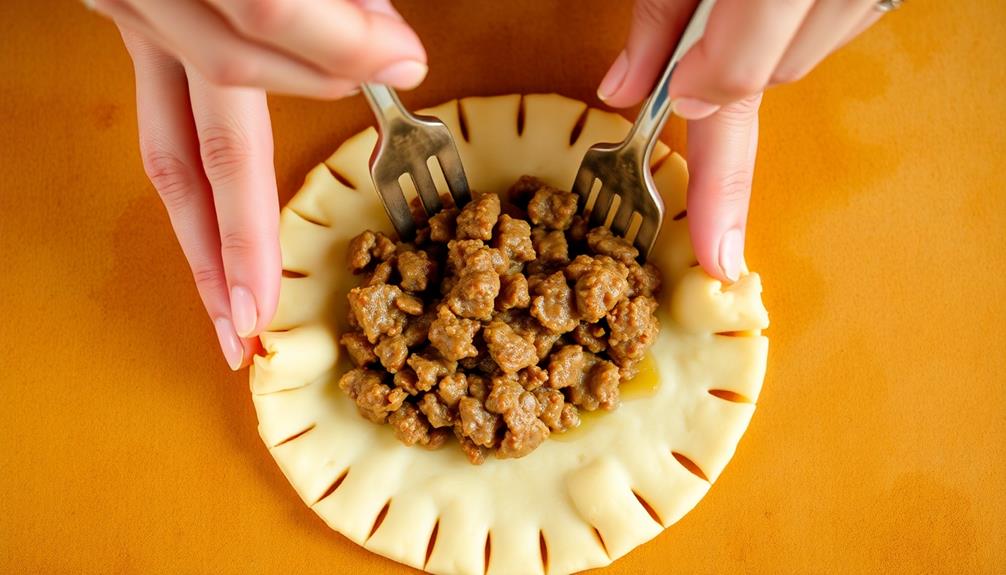
Gently fold the filled dough circles in half, creating a half-moon shape. Pinch the edges together, sealing the dough to lock in the filling. Use your fingers to crimp and seal the edges, creating a decorative pattern. This helps prevent the filling from leaking out during frying.
Next, you'll want to use a fork to press down and further seal the edges. This creates a sturdy seal that can withstand the high heat of frying. Be sure to apply even pressure all the way around the dough, crimping firmly but carefully. The goal is to create a tight seal that keeps the delicious filling inside.
Once the dough is sealed, you're ready to fry your sambousek! Heat oil in a pan and gently add the filled and sealed dough circles. Fry them until they're golden brown on both sides. Drain on a paper towel-lined plate, and enjoy your freshly made Lebanese empanadas!
Step 5. Fry Filled Dough Until Golden Brown
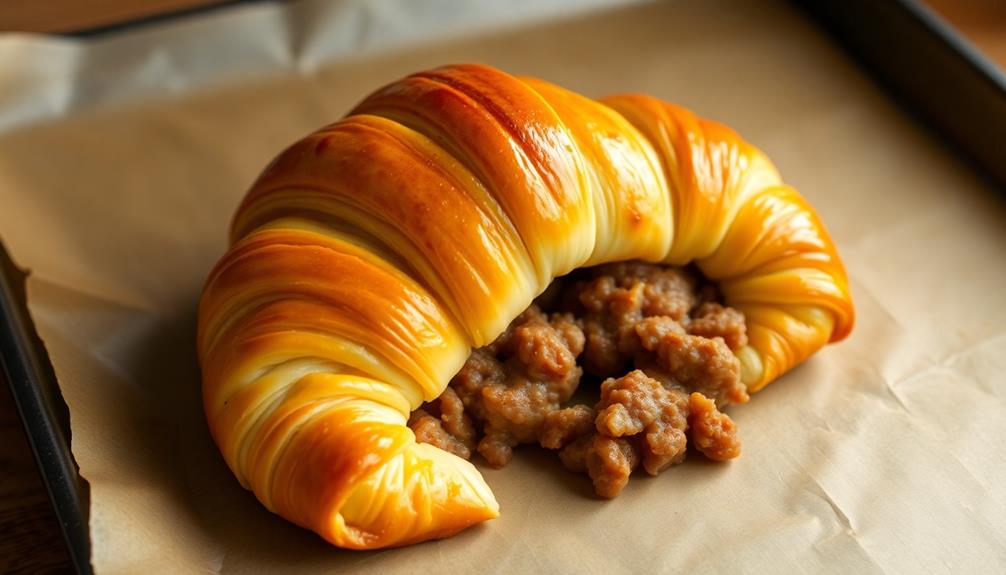
To fry the filled and sealed dough, heat oil in a pan over medium heat.
Once the oil is hot, gently lower the stuffed pastries into the pan. Fry them for 2-3 minutes per side, flipping them carefully with a slotted spoon. You'll know they're ready when they turn a gorgeous golden brown.
Be sure to work in batches, so you don't overcrowd the pan. This ensures the dough cooks evenly and gets that perfect crispy texture.
As each batch finishes, transfer the fried sambousek to a paper towel-lined plate to drain off any excess oil.
Now, the fun part – time to plate and serve your homemade Lebanese empanadas!
Arrange them on a platter and watch your family and friends' faces light up as they take their first bite. The flaky pastry and savory filling are simply irresistible.
Enjoy your delicious handiwork – you've earned it!
Final Thoughts
After exploring the rich history and tantalizing flavors of the Lebanese Sambousek, it's clear that this savory pastry is a true culinary delight.
The perfect balance of crispy dough and aromatic fillings make it a mouthwatering treat that's sure to satisfy. Whether you enjoy the classic cheese-stuffed version or the ground meat-filled variety, each bite is a delightful explosion of flavors.
Sambousek are the perfect snack or appetizer, and they're easy to make at home with a little practice. So why not gather your friends and family, and have a Sambousek-making party?
You can experiment with different fillings, get creative with the shapes, and bond over the joy of crafting these tasty Lebanese pastries. Sambousek are a testament to the rich culinary traditions of Lebanon, and they're sure to become a new favorite in your household.
Frequently Asked Questions
How Long Do Sambousek Last After Being Cooked?
Cooked sambousek can last for a surprisingly long time! Depending on how they're stored, these delectable pockets of goodness can stay fresh for 3-5 days.
Just make sure to keep them in an airtight container in the fridge. That way, you can enjoy your sambousek for days after cooking them.
Mmm, doesn't that sound tasty? With a little planning, you can savor these treats all week long.
Can Sambousek Be Frozen and Reheated?
Can you freeze and reheat those yummy pastries? You bet!
Sambousek are perfect for freezing. Just pop 'em in the freezer, and when you're ready, simply reheat in the oven.
They'll be as good as new – crispy on the outside and delicious on the inside. This makes them a super convenient treat to have on hand whenever a craving strikes.
What Fillings Can Be Used in Sambousek Besides Meat?
Absolutely! Sambousek fillings aren't just about meat – you can get creative with all sorts of delicious options.
How about a tasty veggie filling, like sautéed spinach and feta? Or maybe you'd prefer a savory cheese blend, with that perfect melty goodness.
Heck, you could even try sweet fillings, like apple or pumpkin. The possibilities are endless!
Are Sambousek Gluten-Free or Suitable for Dietary Restrictions?
Gluten-free and dietary-friendly options for sambousek are definitely possible! You can make these tasty treats with gluten-free dough and all sorts of delicious fillings.
Vegetarian, vegan, or even dairy-free sambousek are a breeze. Just get creative with veggies, cheese alternatives, or tasty spices.
No matter your dietary needs, you can enjoy the delicious flavors of sambousek. So, don't be afraid to give these a try – they're sure to be a hit!
What Is the Origin of the Name "Sambousek"?
Ah, the origin of the name "sambousek" – it's a fascinating one! The word is actually derived from the Persian word "sambosa," which refers to a savory pastry that's been around for centuries.
When this delicious treat made its way to the Middle East, the locals adapted the name to "sambousek." Pretty cool, right?
It's amazing how food can travel and evolve, taking on new names and flavors along the way. The story behind this tasty little pastry is just as mouthwatering as the snack itself!
